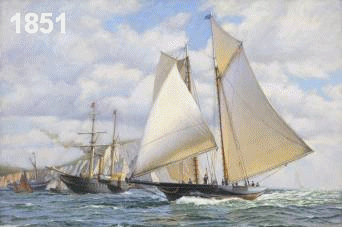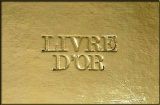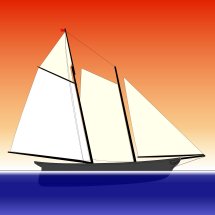 AMERICA'S CUP
AMERICA'S CUP1851-1937
"If we can fly today in the San Francisco Bay, this is because there have been "adventurers" like Walter Greene and Mike Birch.
To understand the future, we must know and respect the past."
Loïck PEYRON (Voiles et Voiliers July 2014)
![]()





 No sooner had Galatea followed in the wake of Genesta as a defeated challenger than Albion's sons set out for another trial for the cup. This time the challenge came from Scotland, the Royal Clyde Yacht Club sending a letter proposing a race in 1887 on behalf of Mr. James Bell, with a boat of about the size of the Mayflower.
No sooner had Galatea followed in the wake of Genesta as a defeated challenger than Albion's sons set out for another trial for the cup. This time the challenge came from Scotland, the Royal Clyde Yacht Club sending a letter proposing a race in 1887 on behalf of Mr. James Bell, with a boat of about the size of the Mayflower.




 Born in Wivenhoe in 1850, John Carter began sailing at a young age aboard "smacks", the typical fishing boats of Rowhedge and its neighbourhood. At the age of 22, he helmed small yachts and in 1875, he distinguished himself as the skipper of the 10-ton Lancer and later of the 110-ton cutter Moina.
Born in Wivenhoe in 1850, John Carter began sailing at a young age aboard "smacks", the typical fishing boats of Rowhedge and its neighbourhood. At the age of 22, he helmed small yachts and in 1875, he distinguished himself as the skipper of the 10-ton Lancer and later of the 110-ton cutter Moina. An important American impressionist, Reynolds Beal was encouraged early on by his younger brother, noted artist Gifford Beal, to study art abroad. Once Reynolds completed his education from Cornell University in naval architecture, and being from a rather wealthy family, he struck out for Europe, where he informally viewed as much art as he could, primarily in Madrid...
An important American impressionist, Reynolds Beal was encouraged early on by his younger brother, noted artist Gifford Beal, to study art abroad. Once Reynolds completed his education from Cornell University in naval architecture, and being from a rather wealthy family, he struck out for Europe, where he informally viewed as much art as he could, primarily in Madrid... William P. Stephens, long known as the "Dean of American Yachtsmen", and "The grand old man of American Yaching" was born in Philadelphia, Aug. 5, 1854. He was a graduate of Rutgers Preparatory School and Rutgers College in 1873 with a Bachelor of Science Degree.
William P. Stephens, long known as the "Dean of American Yachtsmen", and "The grand old man of American Yaching" was born in Philadelphia, Aug. 5, 1854. He was a graduate of Rutgers Preparatory School and Rutgers College in 1873 with a Bachelor of Science Degree.

